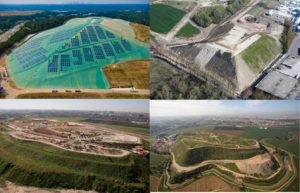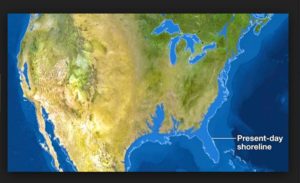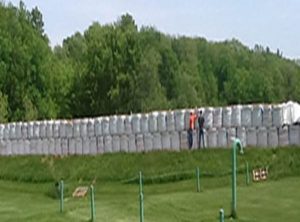Recently my ‘charmigo’ Ramon, who hails from Mexico, told me the only way he would support Mexico paying for a wall is if it was made from biochar. The chuckle I could not suppress was filled with gallows humor. Still it got me thinking, not so much about walls, especially not between the US and Mexico which I believe is a complete waste of time and money as our US food system would quickly unravel if we did not receive the benefit of hard working Mexicans – but about other possible biochar based barricades. Indulge my current biochar fantasy if you will please…
Although many would like to believe the biggest threat to civilization is citizens of one country trying to enter another in an effort to escape famine or fighting, the real threat to humanity and many other life forms is sea level rise. Below is a map of what a future USA could look like if the Arctic ice keeps melting.
Forecasts from 6 – 12’ sea level rise are being projected with more and more certainty. Pretty dire any way you look at it. Many threatened cities are talking about building sea walls to protect themselves. But Mother Nature has a way of overcoming many manmade structures. Which got me thinking about mountains – the ultimate land structure that stands up to rising tides. Which got me further thinking about these kinds of man-made mountains, which I normally bemoan:
 What do all these capped landfills have in common? On the upside (so to speak) they are tall, far higher than the worst case scenario of 12’ sea level rise. On the downside, they are pretty darn ugly and largely devoid of biodiversity. Oh, and most belch CH4 for up to 20 years after they are capped adding more fuel to the climate fire. So creating a great wall of garbage mountains to fend off the rising seas is definitely not the answer. Besides most neighborhoods understandably detest them as they smell and decrease land values.
What do all these capped landfills have in common? On the upside (so to speak) they are tall, far higher than the worst case scenario of 12’ sea level rise. On the downside, they are pretty darn ugly and largely devoid of biodiversity. Oh, and most belch CH4 for up to 20 years after they are capped adding more fuel to the climate fire. So creating a great wall of garbage mountains to fend off the rising seas is definitely not the answer. Besides most neighborhoods understandably detest them as they smell and decrease land values.
But what if instead of garbage under them there hills, we put lots and lots of carbon in the form of (mostly) biochar? Create our own ‘Sea era Terra’ or Sierra Terra (a sierra is a chain of hills or mountains) as it were. Of course the entire ridge could not consist solely of biochar since that would not be structurally viable, but as our indigenous brethren in the Amazon and other cultures discovered, lots of other organic waste could be mixed in to add structural integrity and biological diversity to the mound. Blending charred and uncharred organics (and perhaps some non-toxic organic waste such as crumbled concrete), layer by layer, could build mountains of bounty where trees could be planted to further help pull down CO2 from the atmosphere.
As to the question of where to build, of course current beach homeowners would never allow a C-wall to be built to block their views (short term thinking!). Somehow we seem to have found a way to build pipelines over thousands of mills despite the fact that they destroy lands and landscape, so perhaps there is a way to find land for constructing climate cliffs. If successful such a wall has the potential to enrich a whole new corridor of real estate owners which might suddenly become coastal communities. So the sales pitch to land owners would be more about potential land enhancement rather than environmental hazards.
As to the question of with what, no need to fear that food growing land must be converted to biomass for biochar production. On the contrary, as I have stated many times in this blog the world is nearly drowning in unloved biomass which could be carbonized. Just recently a company told me they will soon be producing 20,000 tons of biochar per year from sewage sludge and tree debris in a small town not too far from me. Converting tons to volume with biochar can be tricky and variable (due to density, particle size, etc.) but imagine 20,000 super sacks (which are already being used to reduce flooding elsewhere though not filled with biochar). Although super sacks come in all sorts of sizes, let’s take your average 2.5′ squared and tall sack for a bit of back of the envelope calculating. There are 5,280 feet per mile, so 2,112 sacks would be needed per mile and a single layer would be 2.5′ tall. That means this one small town could build a 2 mile long x 12′ tall carbon corridor from pyrolyzed sewage and tree waste in just one year. That’s pretty astonishing when you think about it.
(Please note that I’m am not advocating for walls like this one, but rather mountains that promote biodiversity and beauty, but this gives an idea of how quickly and how far carbonized waste could go.) How to create such carbon filled precipices before humanity reaches that other looming precipice…that is the question that fueled my latest fantasy.



